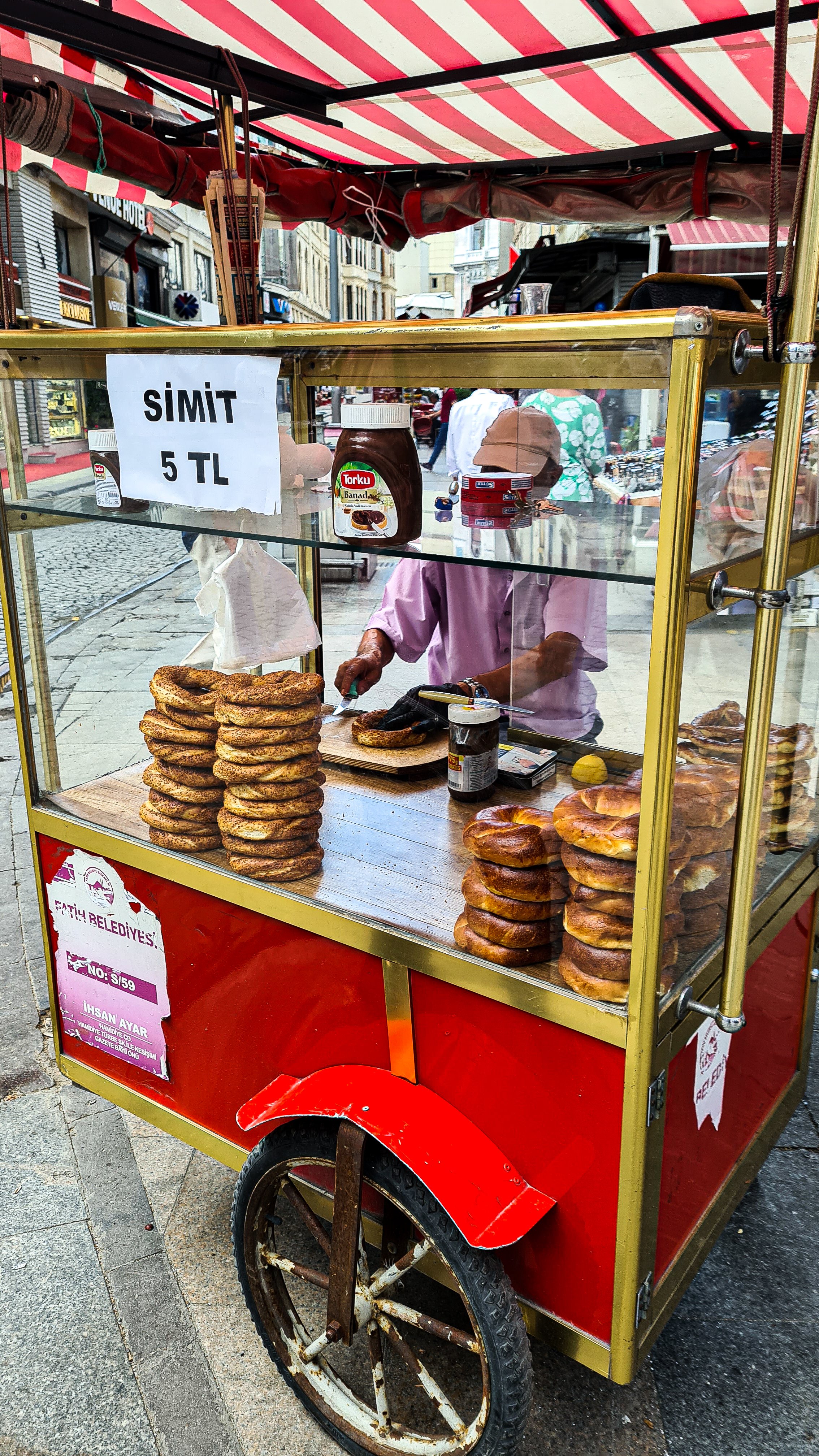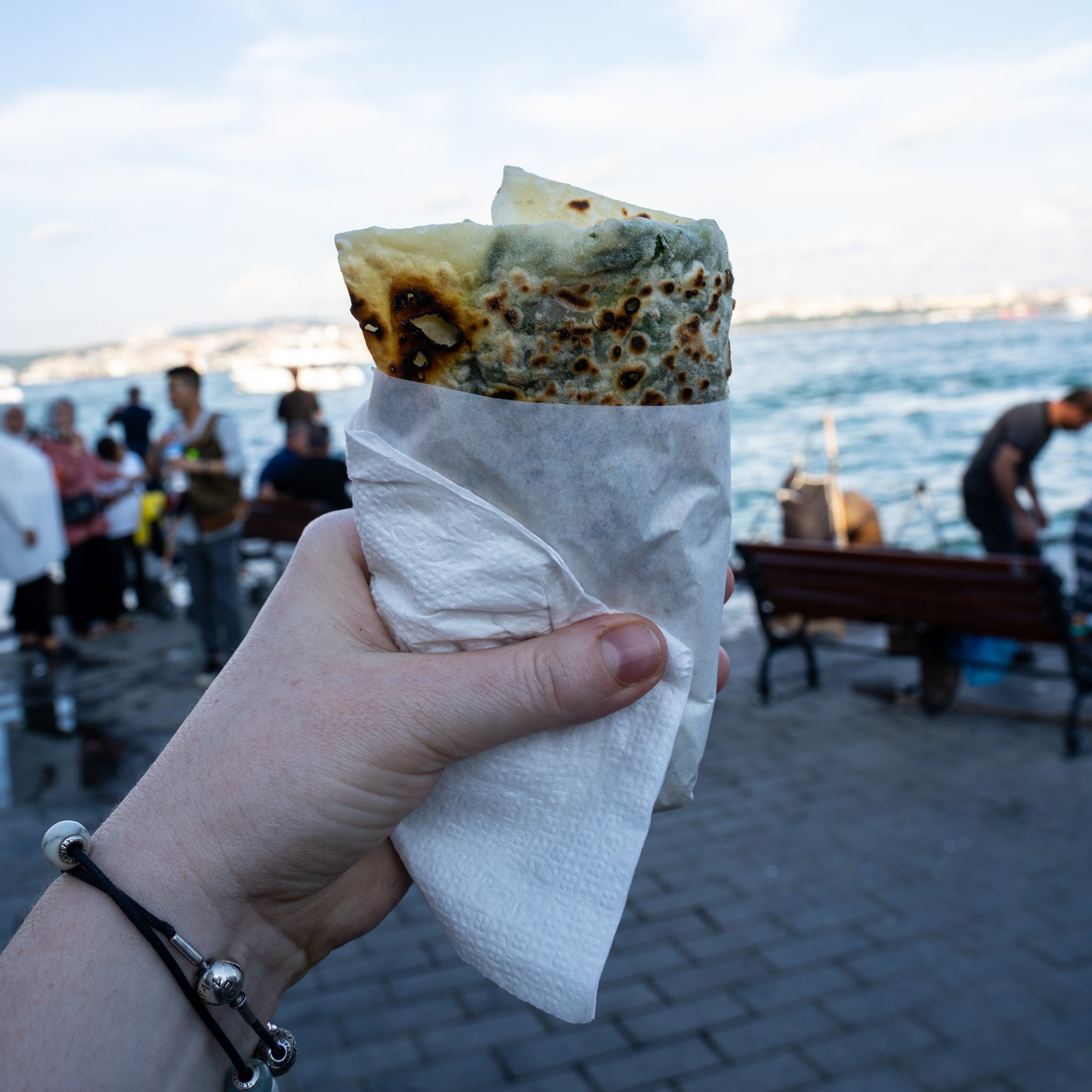Turkish Street Food - Eating Our Way Around Istanbul
Anyone who knows us, knows we love food, especially the kind of food that can be bought street side and for not much money. Some of the best foods we’ve eaten around the world have been street food. From Banh Mi in the busy streets of Hanoi Vietnam, to Cichetti on the medieval streets of Padua Italy, we love it all. Some of our favourite lock down escapism, and indeed, food education, came from watching endless amounts of YouTube videos on local eats around the world. So when we came to Istanbul, we were basically salivating at the thought of its famous street eats. Below (in no particular order) is a list of the ones we tried and loved.
Istanbul Street Food
No matter where you are in Istanbul you will be able to find some fantastic street food. These are just some of our favourite Turkish street eats we found in our time in Istanbul:
Simit
Simit is the local bread and can be found in shops and carts all over the city. It was possibly the most common street food we saw. Shaped like a skinny bagel, you could choose from a plain simit or one covered in sesame seeds. John visited Istanbul as a child and vaguely remember having to chew for hours on an elderly Simit, so it was without high hopes that we purchased one.
We opted for the savoury option of Simit with cheese. I can only assume that little John was either:
a) Young, grumpy and taking it out on the poor Simit (quite likely)
b) Had an unlucky choice in a less than fresh Simit
The Simit we tried was delicious. Slightly chewy, but with a firm exterior, it was the perfect vehicle for the soft cheese. Simit made for an excellent post breakfast snack and easily powered us through till lunch. There is also the option of buying this plain or sweet, where instead of cheese the Simit is spread with Nutella.
Availability: Everywhere, look for the little carts piled high with circular breads, or purchase straight from bakeries found around the city.
Price: 5 Turkish Lira (0.24p or $0.28).
Döner
Possibly no Turkish street food is more famous (especially to the English) than the Turkish Döner kebab. Meat is sliced and then piled into stacks, then formed into elephant leg sized towers of meat, vertically grilled then sliced into bread and served. Although familiar to us, as is often the case, the original is so much better than the imitators. During our time in Istanbul we sampled many a Döner each subtly different, with variations of meat, spicing and sauces. We didn’t have a bad one. The key differences from the kebabs of home that we found were:
Due to the high demand, the meat is constantly fresh and always juicy to the point of sauciness.
Before slicing the meat into the bread, the bread is slapped onto the rotating meat to suck up all the delicious meaty juices.
The meat is frequently covered in a dry spice before any sauce is added.
Very unlike its traditional English post pub counterpart, the vegetables are actually vegetables and not just tarnished memories of what was once a green plant.
I'm sure, if you tried, you could find a bland, tasteless greasy Döner to remind you of England but of all the many we munched, ours were tasty and vibrant without exception. We don't think you can really avoid Döner in Istanbul and we would recommend you don’t even try! We even bought one in the heart of the most touristy spot near us (the base of the Galata Tower) and it was cheap and great.
Availability: Again, everywhere. Every street corner, some shops, mobile vendors and right through to fancy restaurants.
Cost: Variable, the street eat ones that we were typically getting ranged around the 40-60 Turkish Lira (£1.89 - £2.84 or $2.28 - $3.41).
Pide
Looking sort of like a flat canoe that had an illicit affair with a pizza, Pides are often referred to (but not usually by the Turkish), as ‘Turkish Pizza’. Pide is a crispy, oven fired, flat bread with raised sides containing a variety of tasty toppings. Pides are sliced into thin segments and make perfect hand-held street snacks whatever the time of day. Cheap, hot and often cheesy, we found ourselves indulging with these on more than one occasion.
Availability: Everywhere, look for bakeries, hole in the wall joints, bars and restaurants.
Cost: Variable the Pides we ate cost us 25 Turkish Lira (£1.18 or $1.42).
Kokoreç
Kokoreç or Kokoretsi is one of those foods better left unexplained. Imagine you had to describe to an alien the English sausage.
“Basically we grind up lots of animal bits and stuff them back into their own intestines… it’s delicious!” See! The description doesn’t exactly sell the product, and it’s the same with Kokoreç. On a horizontal spit, lamb offal, sweetbreads, heart and kidneys are wrapped in intestines, grilled over flames and then sliced, diced and put between bread. Even as we type this, we know this is hard sell but please give it a go. It’s nothing as gamey as the ingredient list may make it seem, it was peppery, oniony, meaty and satisfying. Remember you eat sausages!
Availability: Very common, look for the horizontal skewers that look like they’re wrapped in bacon (it’s definitely not bacon).
Cost: 30 Turkish Lira for a quarter (£1.42 or $1.71).
Gözleme
We stumbled upon Gözleme whilst wandering along the Galata waterfront. A savoury stuffed crepe, cooked over what could be described as an up-turned wok heated from below. Gözleme can be stuffed with many different ingredients both meaty or veggie. We opted for the Spanakli Gözleme which was stuffed with spinach, onions and herbs. Chewy, crunchy and packed full of green flavours, it was a delightful fresh contrast to the heavy meats and thicker doughs of the day.
Availability: We found this east of the Galata Bridge, near to the Karakoy ferry terminal. Look out for a large red stall and the smiling ladies cooking the Gözleme out front. There is also a covered seating area within the stall.
Cost: 30 Turkish Lira (£1.42 or $1.71).
Stuffed Mussels - Midye Dolma
A cold delicacy found on streets throughout the Capital. Midye Dolma were highly recommended to me by a friend who used to live in Istanbul. Midye Dolma are typically mussels stuffed with herbed rice, served cold with a squeeze of lemon juice. Vendors have a variety of mussel sizes to choose from and you eat these street side in one bite using the other half of the mussel shell as a scoop/spoon. These mini bites were totally unexpected (for some reason Ellie thought they would be warm)! They are herby mixed with the taste of the sea and with a zing of citrus. These ubiquitous snacks are a must try.
Availability: Everywhere. Come the evening, look out for sellers holding a circular tray of mussels in a variety of sizes.
Cost: We paid 8 Turkish Lira (0.38p or $0.45) for two medium sized mussels, but depending on the size of the mussel you chose, expect to pay anything from 5 to 15 Turkish Lira.
Baklava
Ellie is a fiend, a devil in human skin, a hoover with an endless appetite…. At least when it comes to Baklava. If I was to survive our Istanbul trip, there was no option, Ellie must be supplied with Baklava. So even though these are not technically street food, we have included them here.
Myriad layers of crepe paper thin pastry, stuffed with pistachios nuts and soaked in sugar syrup. Baklava are truly decadent sweet treats. We purchased our Baklava from a little old lady in a tiny shop at the bottom of our street. She only sold three varieties when we were there, so we brought all three to try. Sweet (John says to the point of sickness, but I disagree) and sticky, these little one biters are a fantastic accompaniment to strong coffee, and make an excellent pick me up should your sugar need replenishing. Or if you’re a devil in human form an can only be appeased by sugary snacks.
Availability: Everywhere, look out for speciality shops.
Cost: A little more than you expect (but totally worth it) we bought ours for 80 Turkish Lira (£3.79 or $4.55).
Fresh Fruit Juice
After climbing the multiple hills of Istanbul and gorging on heavy meats, breads and Baklavas, you may find yourself in need of some fresh fruit refreshment. Luckily Istanbul (especially the Galata district) is well equipped with juice shops that will squeeze your fruit of choice into a fresh tasty beverage. You will see colourful stands proudly displaying a rainbow of fruits. Choosing from this plethora of fruits can be difficult, but regardless of choice your fruit will be chopped, juiced and poured into a cup. Prices range depending on cup size (much like bras) and fruit choice (unlike bras) with apple and orange being the cheapest and the more exotic fruit being pricier. These juices were a much needed refreshment when tackling a day out in the busy sunny streets of Istanbul.
Availability: In the Beyoğlu/Galata district we found these stalls everywhere. They were not quite as common outside of these areas but are easily spotted by the massive fruit displays outside each stall.
Cost: Ranges depending on cup size/fruit. We paid 30 Turkish Lira for a small Pineapple juice, one of the most expensive fruits (£1.42 or $1.71).
We were only in Istanbul for a week, but these were some of our favourite street snacks we tried. This list is of course by no means exhaustive, as it would take several lifetimes to taste and catalogue all Istanbul has to offer. Whatever you choose to munch upon, we don’t think you can go far wrong, unless you end up in McDonalds.
Thanks for reading.
John & Ellie x
#adventuresofjellie
If you’re found this blog helpful, entertaining or you just fancy supporting us, please click the button below!
If you’ve enjoyed reading this article, why not save the pin below?










